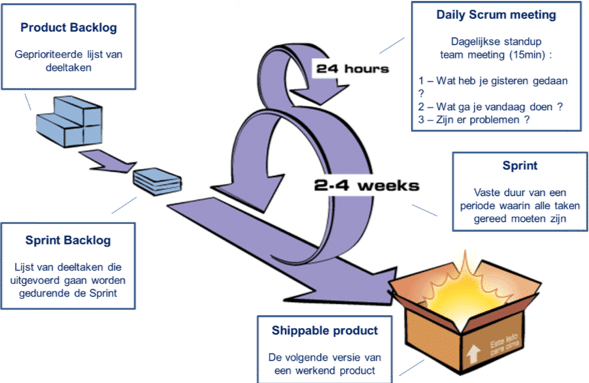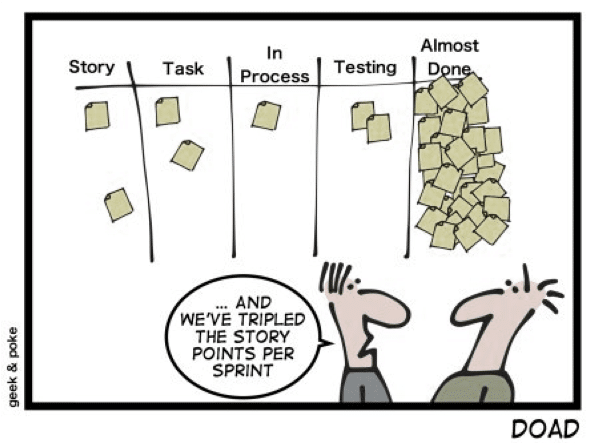SCRUM methodology: “Rocket science” or common sense
Many have heard about SCRUM. In fact, in a number of organizations, it is being used successfully. But what does SCRUM really mean and in what ways can it be employed? SCRUM is a very flexible but effective tool for product development. The SCRUM methodology can be used to deal with late-changing customer requirements and wishes. In short sprints of 1 to 4 weeks, multidisciplinary teams work to deliver products.
Daily efficient, results-oriented management of a project
SCRUM is a methodology, which helps drive a project on a weekly or daily basis. This methodology has its origins in product development. Later, it was successfully adopted by the software industry. Here, designers had to deal with much less clear customer requirements and ever-shorter lead times. Seemingly contradictory requirements, after all, in various project management techniques, we have learned that we must have clear customer requirements up front in order to deliver a project on time and on budget. However, times have changed. Everything is now about flexibility. From this emerged an approach called “Agile Project Management.” One of the corollaries of this is SCRUM.
Systematic and simple
SCRUM is a systematic approach based on a set of clear principles:
- Commitment: say what you will do and do what you say;
- Troubleshooting: identify and address disruptions immediately:
- Simple: clear and with set feedback times
Lean as a basis
The basis for the SCRUM methodology is Lean. Waste should be eliminated and each step in the process adds value that a customer is willing to pay for. Therefore, the customer disconnection point takes place as late as possible so that its requirements can be optimally addressed.
Furthermore, the learning effect should be reinforced, delivery is as fast as possible, the team is accountable and quality is the result of the process. Finally, it looks at the whole so that there are no sub-optimizations.
The steps within the SCRUM methodology
The SCRUM methodology includes the following steps (see also Figure 1):
Defining the product backlog
The product backlog is a list of functionalities (customer requirements) to be added to the product/project.
Determine the sprint schedule
A sprint is a fixed period (2 to 4 weeks) in which an amount of work must be performed
Sprint version
During the execution of the Sprint, a daily SCRUM meeting takes place. During this meeting, each team member answers 3 questions:
- What did you do yesterday?
- What are you going to do today?
- Are there obstacles in your path?
At the end of the sprint, the result is delivered. This is always accompanied by a Sprint Review, a meeting to show all stakeholders (Team, Product Owner and Stake holders) what has been developed and a Sprint Retrospective, a meeting with the team and the Product Owner to discuss how things can be improved or changed in the next sprint.
This entire process is repeated, just until the final product is delivered.

Figure 1 – Schematic representation of the SCRUM methodology
The SCRUM organization
SCRUM works especially well when the roles are well distributed. The product owner determines the product’s functionality, end date and content, prioritizes functionality in order of “added value,” and accepts the final result (or not). The SCRUM master is the process owner who ensures that the “SCRUM process” runs smoothly and leads the daily SCRUM meeting. He or she also ensures that potential bottlenecks are removed. Finally, there is a self-managing multidisciplinary team consisting of 5 to 9 people who execute the Sprints.
“In short, SCRUM is not rocket science but a well-defined approach to project management that ensures that the necessary tasks are picked up at the right time, but also executed at the right time, such that customer requirements can be met. The ultimate goal is to use SCRUM to deliver our projects on time, completely and on budget.
Share your experiences and learn from others
If you use SCRUM in your daily practice, we invite you to share your experiences with us through our Symbol User Group. Of course, there will also be an opportunity here to ask questions and share best practices.

Latest news/blogs
Join our Orange action
From ISO 9001 to IATF 16949As consultants with expertise in ISO 9001 quality management systems,...
From ISO 9001 to IATF 16949
From ISO 9001 to IATF 16949As consultants with expertise in ISO 9001 quality management systems,...
Improving focus: Initial results from our survey
Improvement in focus: Initial results from our research Every year, organizations invest hundreds...


